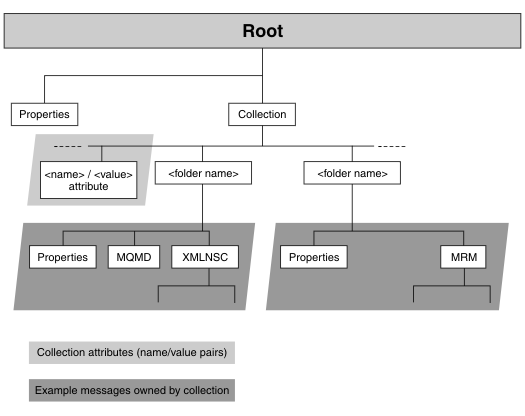A message collection is a message
that consists of a Properties header
and a single domain element named Collection.
The Collection folder contains
a number of child messages, each of which can contain a Properties folder, a number of headers
(such as MQMD), and a body. A message collection can also have zero
or more attributes that are name/value pairs. The name of an attribute
must be unique within a message collection. A standard attribute for
the message collection is an attribute called CollectionName.
The
following figure shows an example of a message collection structure.
You can create a message collection by using Java, and the MbMessageCollection
class, to group messages together for parsing, or create a message
collection that must be constructed to represent a particular data
structure, such as a CICS channel
data structure.
To configure a message collection by using Java, complete the following steps:
- Create a new message by using the following example:
// create new message
MbMessageCollection outMessage = new MbMessageCollection();
MbMessageAssembly outAssembly = new MbMessageAssembly(inAssembly,
outMessage);
- Create a Properties folder
for the collection by using the following example:
// create top level Properties folder and data
MbElement omroot = outMessage.getRootElement();
MbElement properties = omroot.createElementAsFirstChild("Properties");
MbElement property1 = properties.createElementAsLastChild(
MbElement.TYPE_NAME_VALUE, "myProperty1", "propertyData1");
MbElement property2 = properties.createElementAsLastChild(
MbElement.TYPE_NAME_VALUE, "myProperty2", "propertyData2");
- Create the name value pairs by using the following example:
// create collection attributes (name/value pairs)
MbElement cn = outMessage.createNameValue("CollectionName", "myCollectionName");
MbElement nv1 = outMessage.createNameValue("NAME1", "Value1");
MbElement nv2 = outMessage.createNameValue("NAME2", 12345);
As
with message folders, the domain element is always the last child
of the message property.
- The following example shows the procedure to create a message
within the collection. Steps one, two, and three are repeated.
public void evaluate(MbMessageAssembly inAssembly) throws MbException {
MbOutputTerminal out = getOutputTerminal("out");
// create new message
MbMessageCollection outMessage = new MbMessageCollection();
MbMessageAssembly outAssembly = new MbMessageAssembly(inAssembly,
outMessage);
// create top level Properties folder and data
MbElement omroot = outMessage.getRootElement();
MbElement properties = omroot.createElementAsFirstChild("Properties");
MbElement property1 = properties.createElementAsLastChild(
MbElement.TYPE_NAME_VALUE, "myProperty1", "propertyData1");
MbElement property2 = properties.createElementAsLastChild(
MbElement.TYPE_NAME_VALUE, "myProperty2", "propertyData2");
// create collection attributes (name/value pairs)
MbElement cn = outMessage.createNameValue("CollectionName", "myCollectionName");
MbElement nv1 = outMessage.createNameValue("NAME1", "Value1");
MbElement nv2 = outMessage.createNameValue("NAME2", 12345);
// create folder 1
MbElement folder1 = outMessage.createFolder("folder1");
// create properties for folder 1
MbElement folder1properties = folder1.createElementAsFirstChild("Properties");
MbElement folder1property1 = folder1properties.createElementAsLastChild(
MbElement.TYPE_NAME_VALUE, "myFolder1Property1", "folder1propertyData1");
MbElement folder1property2 = folder1properties.createElementAsLastChild(
MbElement.TYPE_NAME_VALUE, "myFolder1Property2", "folder1propertyData2");
// create body of folder 1
MbElement mrm = folder1.createElementAsLastChild("MRM");
// create message domain element of folder 1
MbElement msg = mrm.createElementAsLastChild(MbElement.TYPE_NAME,
"msg", null);
// create data within the message body for folder 1
MbElement data = msg.createElementAsLastChild(
MbElement.TYPE_NAME_VALUE, "data", "myData");
// create folder 2
MbElement folder2 = outMessage.createFolder("Folder2");
// create properties for folder 2
MbElement folder2properties = folder2.createElementAsFirstChild("Properties");
MbElement folder2property1 = folder2properties.createElementAsLastChild(
MbElement.TYPE_NAME_VALUE, "myFolder2Property1", "folder2propertyData1");
MbElement folder2property2 = folder2properties.createElementAsLastChild(
MbElement.TYPE_NAME_VALUE, "myFolder2Property2", "folder2propertyData2");
// create body of folder 2
MbElement xmlnsc = folder2.createElementAsLastChild("XMLNSC");
// create message domain element of folder 2
MbElement msg2 = xmlnsc.createElementAsLastChild(
MbElement.TYPE_NAME, "msg2", null);
// create data within the message body for folder 2
MbElement data2 = msg2.createElementAsLastChild(
MbElement.TYPE_NAME_VALUE, "myData2", "myXMLData");
try {
out.propagate(outAssembly);
} finally {
// clear the outMessage even if there's an exception
outMessage.clearMessage();
}
}

 Last updated Friday, 21 July 2017
Last updated Friday, 21 July 2017